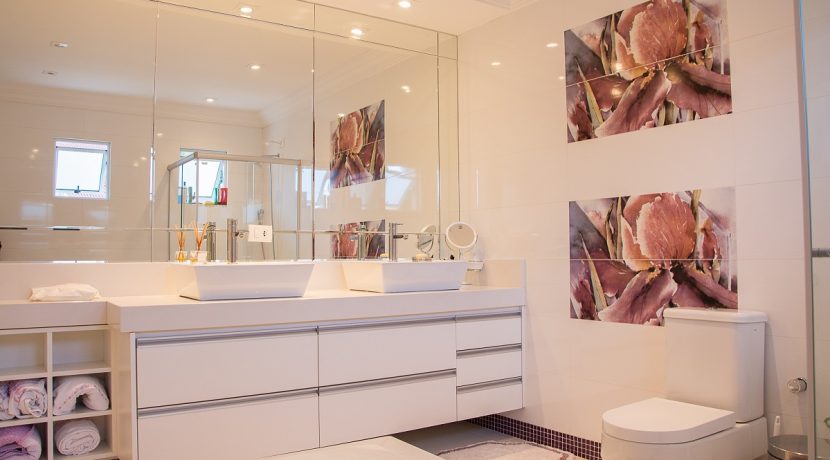Lift the stopper lever to the closed position.
Unscrew the retaining nut that holds the pivot rod in position.
Pull the pivot rod out of the drain pipe to release the stopper. In and around the stopper could be where much debris is found. Clean the area with a small wire brush.
If the clog is still there, try using a half-cup plunger. To use it, first stuff a wet rag into the overflow opening. This is an important step that many people forget to do. The rag prevents air from breaking the suction of the plunger.
Press the cup over the drain and run water over the cap to cover. Turn off the water.
Move the plunger in a quick up-and-down motion to break up the clog.
Pro Tip
A probing tool (also known as a grabbing tool) can be used to stick down the drain to remove the clog.
STEP 1
Clear a Clog Under the Sink
If the clog still isn’t cleared, it’s time to go under the sink and remove and clean the sink drain trap. Supplies needed: a bucket, a small wire brush and channel-type pliers.
Place the bucket under the trap to catch water and debris.
Loosen the slip nuts on the trap bend with channel-type pliers. Unscrew the nuts by hand and slide them away from the connectors.
Remove the pipe and clean out any of the debris with a small wire brush; rinse with water.
Reinstall the trap bend and tighten the slip nuts with the channel-type pliers. Make sure all the pieces form a tight joint. Don’t force a crooked joint, it could start leaking.
Pro Tip
To protect pipes from scrapes, place duct tape on the end of wrench before using it on pipes.
STEP 2
Clear a Plunger-type Drain
For a plunger-type drain remove screws on the cover plate. Carefully remove the cover plate and all the mechanisms from the overflow drain opening.
With a small wire brush clean any debris from the links and the plunger pieces of hardware. After cleaning, lubricate the pieces with heatproof grease.
STEP 3
Clear a Pop-up Drain
For a pop-up tub drain, raise the trip lever to the full open position. Carefully pull the stopper and rocker arm assembly from the drain opening.
Clean hair or debris from the rocker arm with a small wire brush.
Remove the screws from the cover plate. Pull the cover plate, trip lever and linkage from overflow drain.
Remove hair and debris. Remove corrosion with a small wire brush dipped in vinegar. Reinstall.
Pro Tip
Investing in a hand auger tool may be useful. This tool is great for clearing out clogged drains. An auger cable needs to be pushed into the opening until it meets resistance; that indicates a clog. Some clogs, such as a sponge or hair, can be snagged and retrieved. Pull an obstruction out by releasing the auger lock and cranking the handle clockwise.
STEP 4
Unclog a Toilet with a Plunger
Most toilet clogs are the result of curious kids who stick anything from toys to toilet paper down the toilet to see if it will flush. Here’s how to get the job done.
First, remove excess water with a bucket.
Using a flanged plunger, place the cup over the drain outlet opening in the toilet. Plunge up and down rapidly.
Slowly pour a bucket of water into the bowl to flush debris through the drain.
If the toilet doesn’t drain, repeat plunging or try a closet or toilet auger.
STEP 5
Unclog a Toilet with an Auger
A toilet auger has a long handle with a crank and a plastic sleeve at the bend so the cable won’t scratch the toilet. Here’s how to use it.
Loosen the setscrew on the auger and push the cable into the drain until it stops.
Tighten the setscrew so there is about 6″ of cable between the auger and the pipe (too much cable will kink). Crank clockwise and push forward. The auger may push the obstruction through.
If the auger grabs something, pull it out, but test the toilet to determine whether it is unclogged. This process may need repeating.
If the toilet continues to flush sluggishly or overflow after plunging and auguring, the toilet will have to be removed to reach the object. That’s when it’s time to call in the professionals.
So when it comes to cleaning the clogs, use the three tools professional plumbers call their best friends: the plunger for the sink and toilet, and the two augers for the tub and toilet. They’re easy to use, and they’re a lot safer on pipes than chemicals.
All rights reserved to the initial publisher for HGTV.
Collected and published by Arms &McGregor International Realty® editorial team. Get in touched with us at [email protected]

